Skyscrapers, concrete behemoths, and monumental architectures aren’t technological marvels peculiar to the modern world.
Since the first man began using sticks and stone as weapons, innumerable human inventiveness has given birth to some famous architectural creations that even many modern marvels cannot compare.
The most spectacular of these recorded achievements have come to be recognized as the seven wonders of the ancient world. These top seven architectural masterpieces have remained a source of wonder and amazement for thousands of years.
From the Great Pyramid to the Hanging Gardens of Babylon, these ancient structures have captivated the imagination of people across the world.
Strap on as we explore the engineering feats and timeless stories behind each of these legendary structures, from inception to destruction.
Great Pyramid of Giza (Egypt)
The Great Pyramid of Giza is the most extensive of three pyramids in the Giza Necropolis of Egypt. Constructed around 2560 BC, the Great Pyramid is believed to have been a tomb for the fourth dynasty Egyptian Pharaoh Khufu.
Standing at an impressive height of 139 meters and covering a base area of 53,000 square meters, the Great Pyramid of Giza is the largest among the seven wonders of the ancient world and the last one standing.
Since ancient times, even till now, the Great Pyramid of Giza has been the most accurately aligned structure in the world.
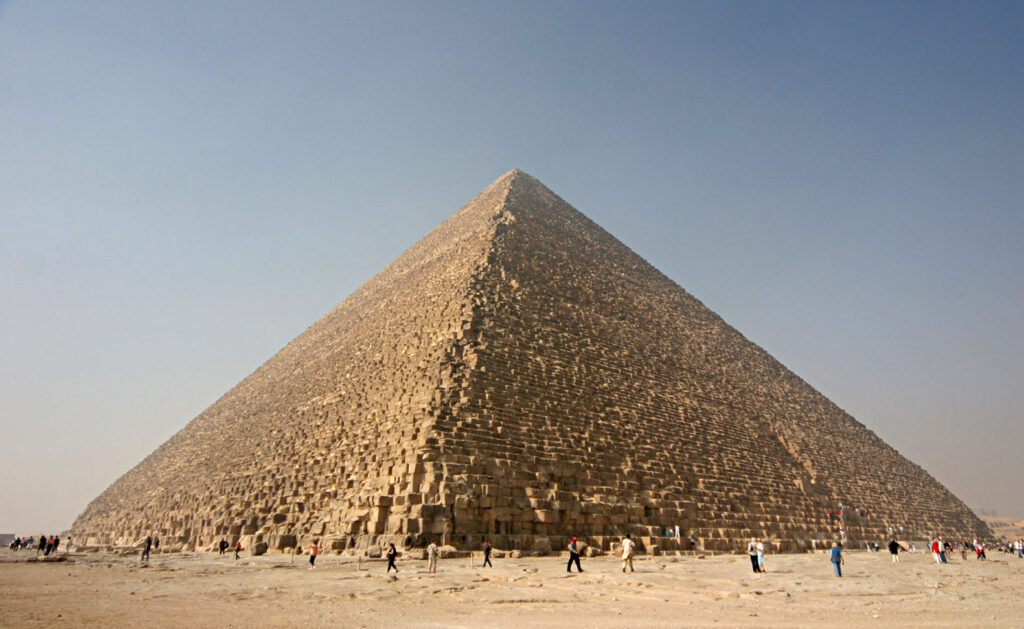
Simply put, it was and is still an architectural marvel, having been built with such precision that its four sides are aligned perfectly with the four cardinal points of the compass.
The ancient Egyptians spent almost 20 years building the structure, which swallowed up an estimated 2.3 million blocks of limestone and granite. Upon its completion, the pyramid towered above all, reigning as the world’s tallest building for more than 4,000 years before modern humans began to build skyscrapers.
Over the years, the Great Pyramid has been the focus of countless research and theories. Many have attempted to uncover the mystery of its construction and purpose.
Theories range from the belief that it was constructed using extraterrestrial help to views that it was built using advanced technology that was lost over time.
Whatever its true purpose, the Great Pyramid of Giza will forever remain one of the world’s most impressive and mysterious monuments.
Hanging Gardens of Babylon (Iraq)
Gardens are a natural representation of nature’s beauty. Typically we would see beautiful gardens spread out majestically over large areas of flat land, in different shapes and styles but still mainly on the face of the earth. However, the hanging gardens of Babylon were and are still an exception to this rule.
Just like its name suggests, this ancient wonder was a structure that defied common sense, with the gardens hanging from towering Babylonian building complexes.
King Nebuchadnezzar II presumably commissioned the hanging gardens around 600 BC as a present to his wife, Queen Amytis, who missed the green scenery of Media, her native land.
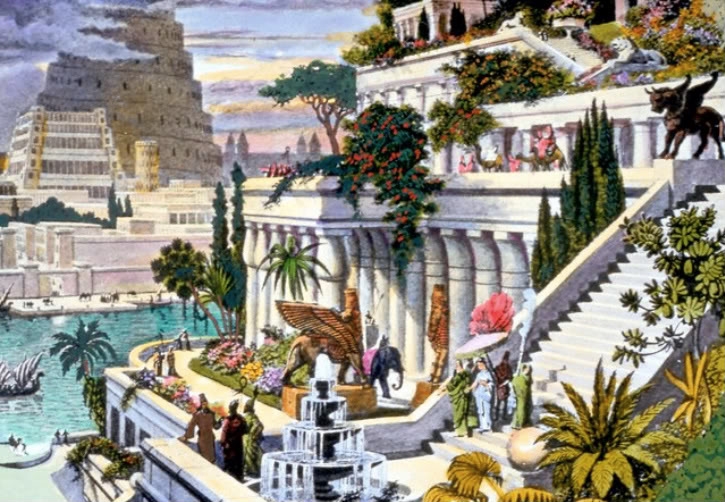
The gardens were an extensive terrace constructed of ascending and descending terraces filled with exotic flowers and trees and irrigated by an intricate system of water channels and pumps.
According to myth, the garden featured an incredible diversity of plants from all over the world. It was so overreaching that the magnificent towering figure could be seen from miles away.
For centuries, this peculiar ancient wonder has been a source of mystery and debate. Historians have speculated about the exact location of the gardens, and there is no definitive answer. Some scholars believe that the gardens were located within the city of Babylon, now modern-day Iraq, while others argue that they were located outside of the city
Ultimately, the gardens’ exact location and existence have yet to be confirmed.
While Archaeologists have uncovered evidence of a massive palace complex in Babylon, no remains of the gardens have ever been found.
Some historians believe that the gardens may have been a myth, while others believe they had once existed in all regality but have been destroyed by natural forces (earthquake).
Despite their unconfirmed existence, the Hanging Gardens of Babylon remain one of the most iconic symbols of the ancient world. They have been referenced in literature, art, and music throughout the centuries and are still fascinating.
Statue of Zeus at Olympia (Greece)
The Statue of Zeus at Olympia is one of the most renowned sculptures of antiquity. Built in 456 BC in the Temple of Zeus at Olympia by the great Greek sculptor Phidias, this ancient world wonder doesn’t pale compared to any of its other six companions.
The statue stands about 12 meters tall and is made of ivory and gold. It depicts the god Zeus seated on a throne with a majestic look on his face. He is dressed in a robe and is ornamented with an olive leaf wreath. In his left hand is a scepter, and in his right, an eagle.
Legend has it that the face and body of the statue were so lifelike that the sculptor Phidias had to add a veil to cover the face of the god to prevent people from believing it was a living being.
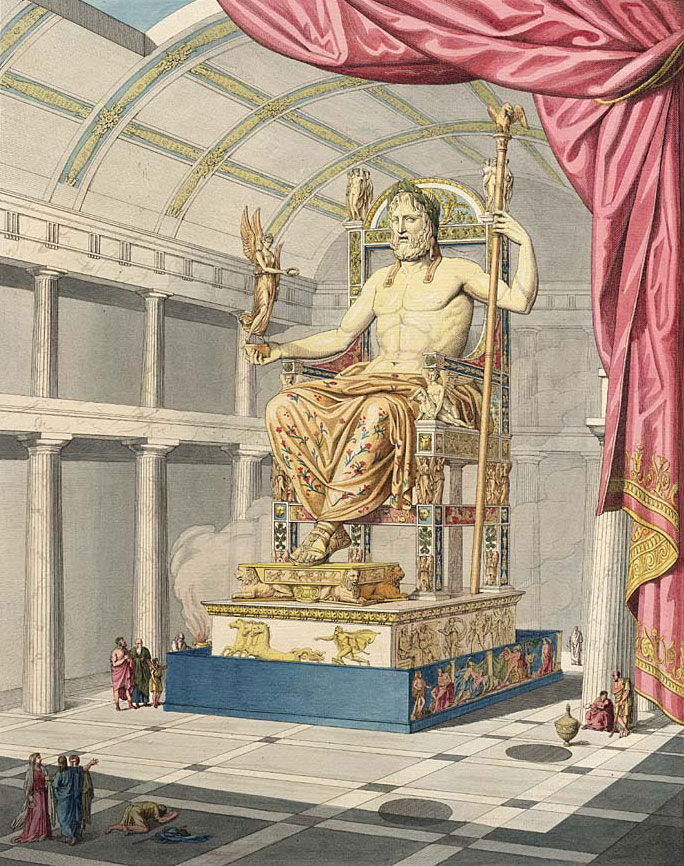
The sculpture was also embellished with precious metals, jewels, and other materials, as well as an ivory and gold throne.
In ancient Greece, the iconic statue was a powerful symbol of authority and prosperity. It was also a source of pride for the Greeks, who considered it a symbol of their culture. They believed that the god of the sky watched over Olympia through this monument.
Over eight centuries passed with the Zeus statue adorning the Olympian temple before Christian priests in the 5th century A.D. persuaded the Roman emperor to close the temple. The monument was later relocated to a temple in Constantinople, where it was reportedly destroyed in an earthquake.
Today, the remains of the statue of Zeus at Olympia can still be viewed. Although the original statue is gone, it still stands as a reminder of the impressive achievements of the ancient Greeks. It is a testament to the power and influence of the gods. It still inspires people today.
Temple of Artemis at Ephesus (Turkey)
The Temple of Artemis at Ephesus is another instance of ancient human ingenuity that dwarfs the best architectural works across history, except for the other ancient wonders.
It was built approximately 550 B.C.E. by Croesus, King of Lydia, in Ephesus, a Greek port city in present-day western Turkey, and dedicated to the Greek goddess Artemis.
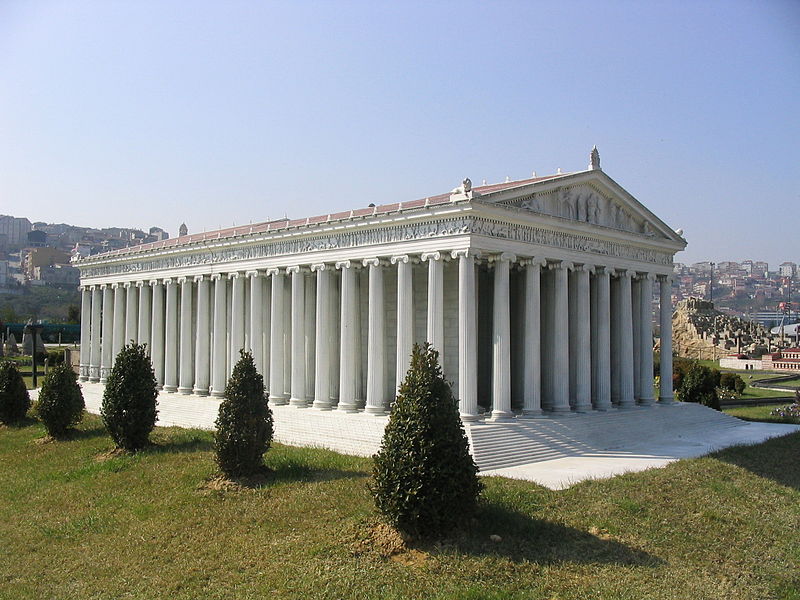
It was a major religious and cultural center of the ancient world, measuring 425 feet by 250 feet and standing 60 feet tall.
The temple was built of marble and was a magnificent edifice. Ancient poets and historians told stories and composed poetry about how it dwarfed Athena’s Parthenon by nearly four times in size. The temple was also decorated with beautiful sculptures of animals and gods, making it an impressive sight.
Not unlike the other wonders, this magnificent temple didn’t last until the modern day. Then, around 356 B.C., a man named Herostratus, who supposedly sought fame, reportedly set it on fire for the first time.
Some years later, in 323 B.C.E., Alexander the Great rebuilt the temple and restored it to its former opulence. But, unfortunately, the temple’s fate wasn’t so different from what it once suffered.
In 262 AD, it was again destroyed by a mob of Christian zealots. Despite these two destructive events, the temple still stands today and is a symbol of the power and beauty of the ancient world.
Over the years, the temple has been the subject of considerable study and debate. Archaeologists and historians have long wondered what secrets this temple might still contain. From its ruins, they’ve been able to piece together a great deal of information about the culture and religion of the ancient Greeks.
Mausoleum at Halicarnassus (Turkey)
Situated in modern-day southeastern Turkey, the Mausoleum at Halicarnassus was one of the most impressive ancient structures whose remains we can still find lying around today.
In the ancient land of Persia, a queen came from a long line of royals and was famous for her valiance and wisdom. Her name was Artemis II of Caria, daughter of King Hecatomnus of Caria. She went on to marry her brother, Pixodarus, who eventually succeeded Hecatomnus as ruler of Caria.
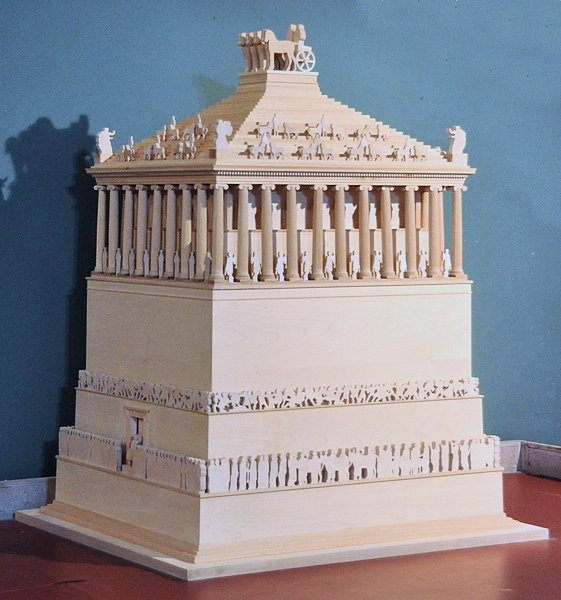
Together, they ruled Caria for many years, conquering many neighboring kingdoms and bringing prosperity to their people.
Sadly, Pixodarus passed away early on, leaving Artemis incredibly grief-stricken. To commemorate his memory, Artemisia ordered a tomb be built for him to be buried.
The tomb eventually became what we now know as the Mausoleum at Halicarnassus.
Satyros and Pythius, renowned Greek architects of their time, designed the Mausoleum, which was built in the shape of a stepped pyramid. It stands roughly 45 meters tall and is adorned on all four sides with exquisite sculptures depicting themes from Greek mythology.
On top of the structure is a chariot pulled by four horses, which is thought to represent Mausolus and Artemisia riding into the afterlife together.
The Mausoleum eventually became one of the original Seven Wonders of the Ancient World, widely renowned for its grandeur and beauty. Unfortunately, in the end, like all others before and after, the mausoleum was largely destroyed in an earthquake. This happened sometime in the 13th century.
The remnant of the site remains in Turkey after thousands of years. The site is now a UNESCO World Heritage Site, and it remains one of Turkey’s most popular tourist attractions.
Colossus of Rhodes
Built in 280 BC, the Colossus of Rhodes is one of the most iconic ancient structures in the world. It was a massive statue of the Greek deity of the sun, Helios, that stood over 30 meters tall.
The statue was another of the original Seven Wonders of the Ancient World related to ancient Greece and was built on the Greek island of Rhodes as a sign of the city’s wealth.
The Colossus was an impressive feat of engineering and artistry. It was constructed from bronze and iron rods and plates and was designed by the renowned Greek sculptor Chares of Lindos.
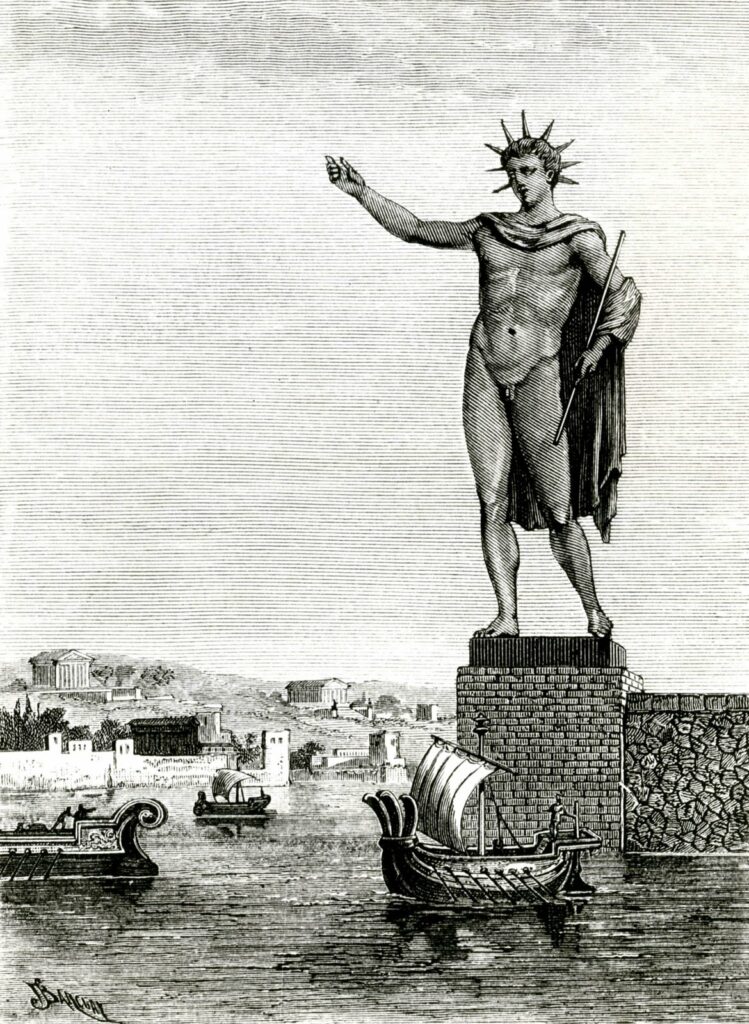
The statue was so large that it was said to have blocked out the sun when it stood atop a 15-meter-high white marble pedestal.
Unfortunately, we can’t witness such magnificence today. The Colossus could only stand for about 54 years before being destroyed by an earthquake in 226 BC.
The ruins of the Colossus still, however, remain and are a popular tourist attraction. Today, visitors can still see the remains of the Colossus sitting menacingly at the port of Rhodes.
The Colossus of Rhodes was a fantastic accomplishment and a symbol of the power and wealth of the ancient Greek world.
Its destruction marked a tragic end to an iconic landmark that symbolized the greatness of the ancient Greeks. Nevertheless, the Colossus will always remain an essential part of history and a reminder of the power and beauty of the ancient world.
Lighthouse of Alexandria
The Lighthouse of Alexandria was a lighthouse in the Egyptian coastal city of Alexandria. Modern historians and scientists believe it to be the first and the most spectacular lighthouse ever constructed.
Sostratus of Cnidus, a Greek architect, designed the Lighthouse. Constructions started and ended somewhere between 280 and 247 BC. The overreaching monument was one of the tallest man-made structures in history, at 400 feet tall.
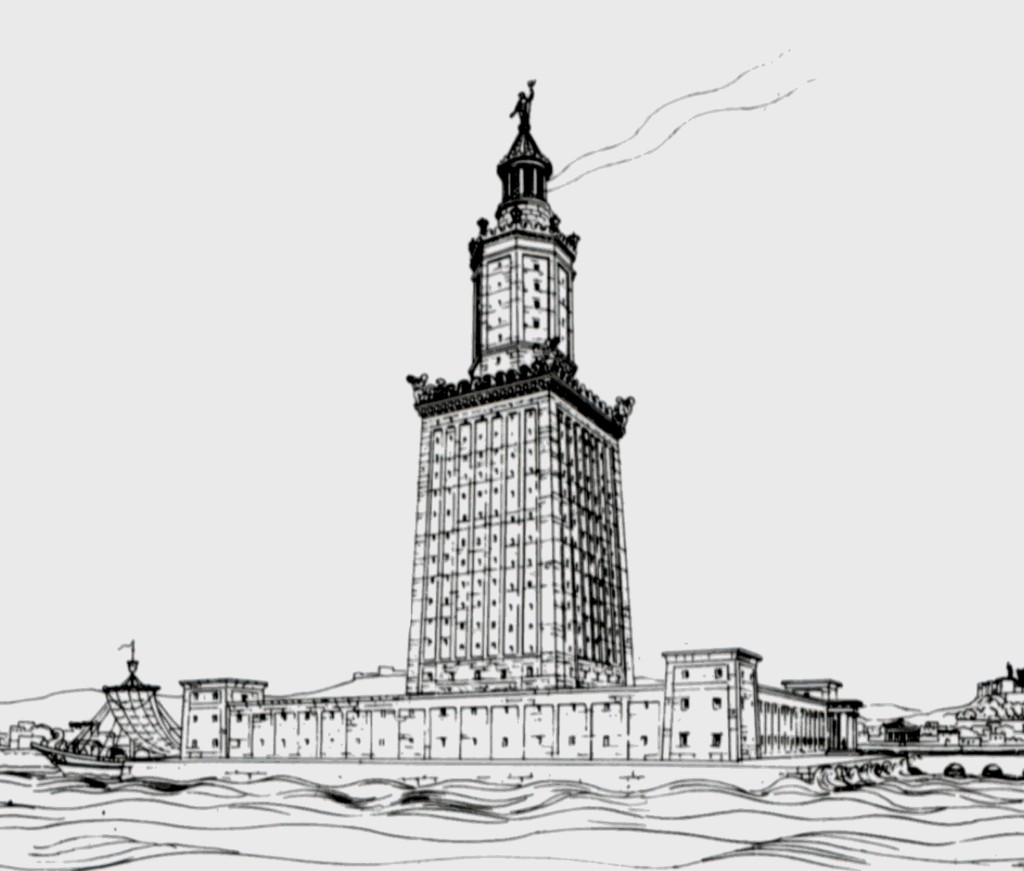
It was constructed on the island of Pharos, which was linked to the mainland via a causeway. The tower was made of three stories of white marble blocks and included a perpetually burning fire at the top to light up the lighthouse.
The lighthouse helped guide sailors from the Mediterranean Sea to the busy port of Alexandria. It symbolized the city’s wealth and power, with its grandeur admired by many people throughout the ancient Mediterranean.
The Lighthouse of Alexandria’s heritage carries on in modern lighthouses worldwide. The ancient structure’s unique architecture, with its three levels of white marble blocks and its beacon of light at the top, is still used in modern times.
It has become a symbol of hope and guidance for millions of travelers and a reminder of the ancient world’s majesty and might.

